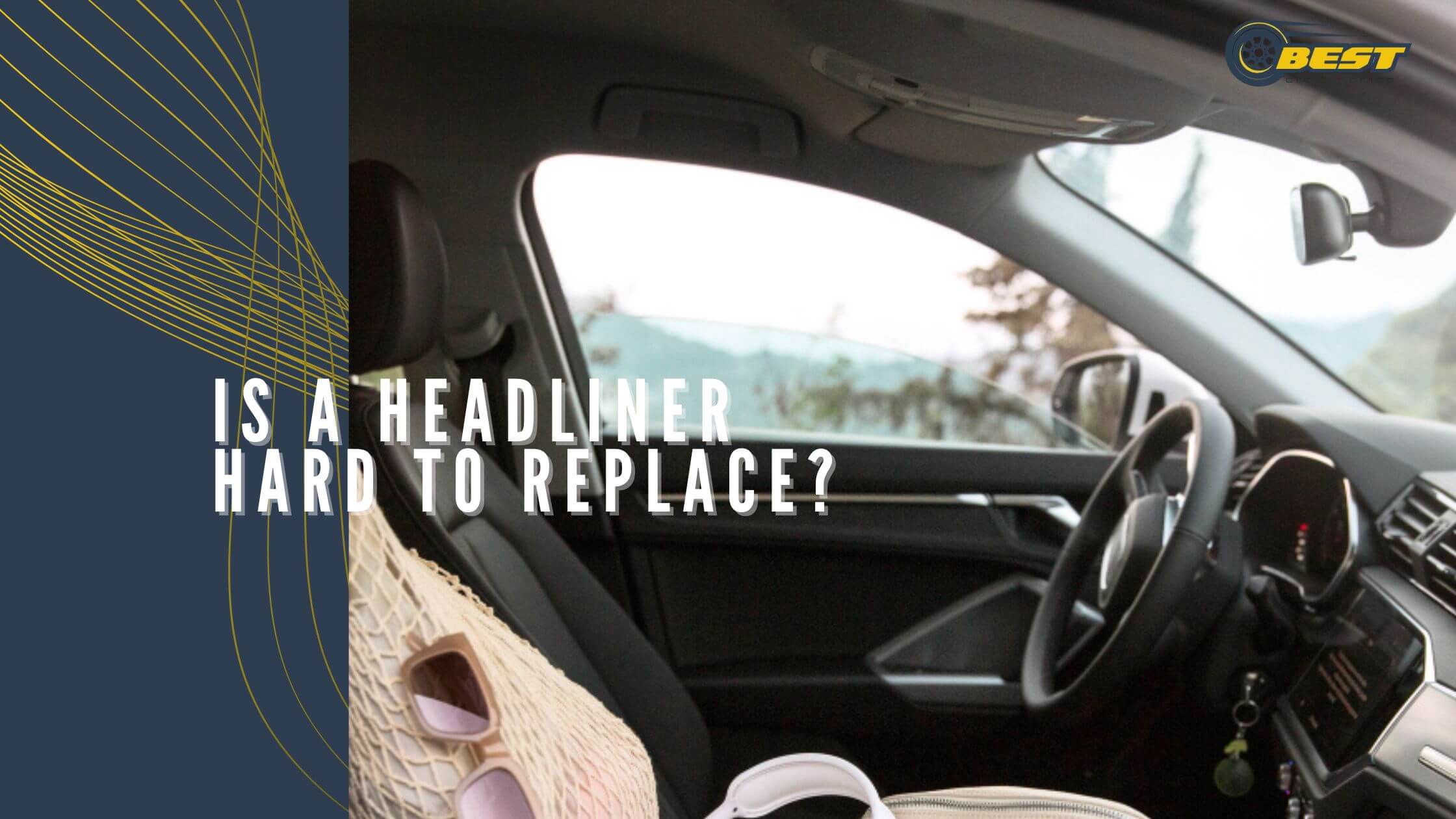Is a headliner hard to replace? For many car owners dealing with sagging or damaged headliners, this question is a frequent concern. Replacing a headliner can be challenging but achievable as a DIY project if you approach it with the right tools, patience, and attention to detail. The difficulty comes from the multiple steps involved, including removing interior trim, working with adhesives, and ensuring an even, wrinkle-free fabric application.
Is a headliner hard to replace? For those with some DIY experience, following careful instructions can make it a rewarding task. The process involves working precisely at each stage, from detaching accessories like visors and lights to handling heat-resistant adhesives for a lasting finish. While replacing a headliner is time-intensive, it can also save the cost of professional services, making it worthwhile for those willing to invest the time and effort.
Contents
Is a headliner hard to replace?
Replacing a car headliner is considered a difficult but feasible DIY project with the right tools, patience, and attention to detail. Below is a comprehensive breakdown to understand the difficulty involved in the task and what to expect if attempting it yourself.
1. Difficulty Level and Overview
- Challenging but Doable: The process of replacing a headliner is challenging mainly due to the number of steps involved and the need for precise handling at each stage. This is not a quick fix—it involves several intricate steps, including removing various interior accessories, detaching the headliner board, and carefully reapplying new fabric with adhesive.
- Attention to Detail Required: Each step demands focus. For example, removing foam residue and evenly applying adhesive are crucial to ensuring that the new headliner looks professional and stays firmly attached, even in high temperatures. Missteps, such as rushing or not evenly spreading adhesive, can lead to a wrinkled or poorly secured headliner.
2. Time Commitment and Tools
- Estimated Time: It typically takes around three hours for a professional to replace a headliner, which can be longer for someone without experience. The process can also vary depending on the size and complexity of the vehicle, with larger vehicles often requiring additional effort and time.
- Essential Tools: The tools required include:
- Screwdrivers to remove seatbelt covers, lights, visors, and other accessories bolted to the ceiling.
- A bristle brush to scrape away the old foam without damaging the board.
- Heat-resistant adhesive to prevent fabric sagging, especially in warm conditions.
- A trim tool for removing panel trim safely.
- Hobby knife to cut out fabric holes for accessories.
- Workspace: You’ll also need a clean, flat workspace to lay the headliner board for applying the new fabric, ideally where it won’t get damaged or dirtied during the process.
3. Professional Cost for Replacement
- Hourly Rate: Professional replacement services generally cost between $75 and $150 per hour, depending on location, the vehicle type, and service provider.
- Total Cost: For a standard vehicle, a headliner replacement might cost around $200 to $350, including materials and labor, with SUVs or vans potentially costing more due to their larger surface area.
- DIY Cost Savings: While it’s possible to do the replacement yourself, the DIY approach can save money if you already have the tools and materials. However, if adhesives or tools need to be purchased, this may impact savings, particularly if multiple attempts are necessary to achieve a smooth finish.
4. Step-by-Step Summary of the Process
- Step 1: Preparation and Removal of Accessories: Begin by removing any accessories attached to the ceiling, including visors, seatbelt covers, lights, and other mounted devices. Many are bolted on, so using the right screwdriver is essential to avoid damage. This step can be tedious but is necessary to access the headliner board.
- Step 2: Removing the Headliner Board: With all accessories detached, unclip and carefully remove the trim panels holding the headliner board. Slide the board out of the vehicle, taking care to avoid bending it.
- Step 3: Foam Removal: Scrape away any old foam from the headliner board using a soft bristle brush. It’s important to do this gently, as damaging the board can complicate the reinstallation.
- Step 4: Applying the Replacement Fabric: Lay the replacement fabric over the board, ensuring there are no wrinkles. Fold half of the fabric back, apply adhesive to one section at a time, and repeat for the other half.
- Step 5: Drying Time: Allow sufficient time for the adhesive to dry thoroughly before handling the headliner again. Following the adhesive’s instructions is critical to achieving a long-lasting bond.
5. Common Challenges and Precautions
- Challenges: Achieving a smooth, wrinkle-free appearance requires practice and patience. The adhesives need to be evenly spread, and fabric should be laid smoothly without bunching.
- Temperature Sensitivity: Selecting a strong, heat-resistant adhesive is crucial since vehicle roofs heat up quickly, which can weaken standard adhesives and cause sagging.
- Cutting for Accessories: After the fabric is secured, precise cutting is necessary to make openings for lights, visors, and other accessories without tearing or misaligning the fabric.
Conclusion
Although difficult, replacing a headliner yourself is achievable by following detailed steps and using the right tools. For those with some DIY experience and a willingness to invest the time, it can be a rewarding project. However, if in doubt, professional help might be more efficient, particularly for complex or larger vehicles where labor-intensive work is needed.
Can you repair headliner without removing?
Yes, it is possible to repair a headliner without removing it entirely, especially if the sagging is limited to certain areas. Here are some key methods for fixing a headliner without taking it out of the car:
1. Using Spray Adhesive
- Procedure: If the headliner is sagging along the edges or sides, you can use a spray adhesive to reattach it. Spray the adhesive on the loose part of the headliner fabric and on the exposed car ceiling where the fabric is peeling.
- Application Tips: After applying the adhesive, wait about 5 minutes for it to become tacky before pressing the fabric back into place. Some people prefer applying two coats of adhesive for better hold.
2. Using Double-Sided Tape
- Procedure: For small areas along the edges, double-sided tape can be a quick solution. Stick one side of the tape to the loose fabric, then press the tape onto the car’s roof. This is an easy and temporary fix for small sections of the headliner that have come loose.
3. Using Pins for a Temporary Fix
- Procedure: Pins can hold a drooping headliner temporarily. This method is simple but may not look as clean or professional. It’s most effective if you need a quick fix before replacing the headliner entirely.
4. Limitations for Center Sagging
- Consideration: If the headliner is sagging in the center, these methods are generally ineffective. Re-gluing the center of the headliner onto the backing board is difficult without removing the headliner entirely.
What does it mean when headliner is sagging?
A sagging headliner refers to the fabric on the car’s ceiling coming loose from its backing board, causing it to droop or hang down. This occurs due to the adhesive that holds the headliner fabric to the backing board deteriorating over time. Exposure to moisture or heat accelerates this breakdown, leading to the fabric separating and sagging. The sagging headliner can interfere with visibility or become a nuisance if it hangs too low.

While a sagging headliner is often best fixed professionally, there are several DIY hacks to address it temporarily:
- Glue: Reattaching loose sections with a specialist headlining adhesive can help if only part of the headliner is sagging.
- Pins: Pins can temporarily hold the fabric to the foam backing but do not provide a lasting solution.
- Staples and Hairspray: Stapling the fabric, then spraying with hairspray to set it, can be a cheap, semi-permanent fix.
- Steam Cleaner and Paint Roller: Using a steam cleaner to soften glue while rolling the fabric flat may work if the adhesive isn’t fully dried out.
- Double-Sided Tape: For sagging around the edges, double-sided tape can help hold the fabric in place.
Experts recommend removing the headliner panel completely to reattach the fabric with new adhesive for a more durable repair.
What tools do I need to remove a headliner?
To remove a headliner, the essential tools include:
- Interior Upholstery Clip Pry Tool: This is critical for prying out clips that secure the headliner shell without damaging the board or fabric. Investing in a quality pry tool will help avoid any damage to the headliner shell.
- T25 Torx Bit with Ratchet and Speed Driver: Needed to remove bolts, such as those holding the rearview mirror in place.
- Inspection Light: This helps when working in tight spaces, allowing better visibility in gaps while engaging or removing clips.
- Cell Phone Camera: Helpful for tight spots where direct sight isn’t possible; you can use it to align or inspect hard-to-see clips by viewing on the phone’s screen.
Lastly, keep hands very clean during the process. Avoid greasy or dusty fingerprints by washing hands frequently or using a microfiber towel to wipe them down.

